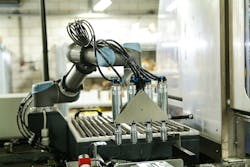Mike's Blog: Distributors warn of collaborative robots' lacking performance
I've written a decent amount on the topic of collaborative robots (cobots) over the last six months—including my February print issue editorial, and a farewell to one "Sawyer" cobot, and the fact that mourning the "death" of robots is now socially normal. And on Monday, a news item showed up in my email that was of further interest on this subject.
Toshiba Machine Distributor TM Robotics has published the results of its new Global Robotics Report in a 36-page document, summarizing the opinions of automation distributors regarding current challenges and trends related to robotics.
Asked what the biggest concerns are that customers have concerning cobots, distributors picked:
- Performance—34.48%
- Safety—27.59%
- Integration into legacy—20.69%
- Programming—10.34%
- Something Else—6.9%
So, perhaps the rise of the cobots will be a more prolonged process than originally thought.
"Clearly, there’s a need for a greater understanding of cobots before manufacturers jump on the collaborative bandwagon—and perhaps a crackdown on the way manufacturers are marketing this new kind of bot, particularly where performance and safety are concerned," the report stated.
TM Robotics also highlighted issues in the traditional industrial robot market. It emphasized distributors' concerns about existing robotics software, with 45% of distributors saying difficult-to-understand software was a common problem. Along with that, 38% of distributors highlighted the issue of robot software compatibility with existing automation systems.
Almost expectedly, the report shows cybersecurity is another area of uncertainty. More than three out of four automation distributors said their customers did not ask for advice about cybersecurity when upgrading to a smart factory—a surprising stat given where things are in the era of Industry 4.0. The report states that when respondents were asked about the features customers specified when choosing a robot, security protocols were not mentioned. Meanwhile, the most popular features customers seemed to be looking for were: simple robot programming (79%), integrated vision (55%), and collaborative activities (48%).
“Customer expectations of industrial robots are changing,” explained Nigel Smith, managing director of TM Robotics. “As a result, the way we deliver robots must change too. No longer are robots simply a tool to increase manufacturing output, but a fundamental part of manufacturers’ goals for digitalization. To meet these expectations, distributors must consider what factors are important to today’s manufacturers."
About the Author


